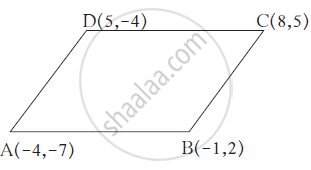Advertisements
Advertisements
प्रश्न
Show that
उत्तर

=
=
BC =
=
From (1), (2), (3) and (4); AB = BC = CD = DA
∴
APPEARS IN
संबंधित प्रश्न
Two vertices of an isosceles triangle are (2, 0) and (2, 5). Find the third vertex if the length of the equal sides is 3.
A (3, 2) and B (−2, 1) are two vertices of a triangle ABC whose centroid G has the coordinates
Prove that (4, 3), (6, 4) (5, 6) and (3, 5) are the angular points of a square.
The line segment joining the points P(3, 3) and Q(6, -6) is trisected at the points A and B such that Ais nearer to P. If A also lies on the line given by 2x + y + k = 0, find the value of k.
The line joining the points (2, 1) and (5, -8) is trisected at the points P and Q. If point P lies on the line 2x - y + k = 0. Find the value of k.
Show that the points A(2,1), B(5,2), C(6,4) and D(3,3) are the angular points of a parallelogram. Is this figure a rectangle?
Find the ratio which the line segment joining the pints A(3, -3) and B(-2,7) is divided by x -axis Also, find the point of division.
Find the ratio in which the point (−3, k) divides the line-segment joining the points (−5, −4) and (−2, 3). Also find the value of k ?
Find the ratio in which the line segment joining the points A(3, 8) and B(–9, 3) is divided by the Y– axis.
ΔXYZ ∼ ΔPYR; In ΔXYZ, ∠Y = 60o, XY = 4.5 cm, YZ = 5.1 cm and XYPY =
Write the coordinates of a point on X-axis which is equidistant from the points (−3, 4) and (2, 5).
What is the distance between the points A (c, 0) and B (0, −c)?
If the distance between the points (4, p) and (1, 0) is 5, then p =
If Points (1, 2) (−5, 6) and (a, −2) are collinear, then a =
What is the form of co-ordinates of a point on the X-axis?
Find the point on the y-axis which is equidistant from the points (S, - 2) and (- 3, 2).
Abscissa of all the points on the x-axis is ______.
The point at which the two coordinate axes meet is called the ______.
If the perpendicular distance of a point P from the x-axis is 5 units and the foot of the perpendicular lies on the negative direction of x-axis, then the point P has ______.
In which quadrant, does the abscissa, and ordinate of a point have the same sign?
